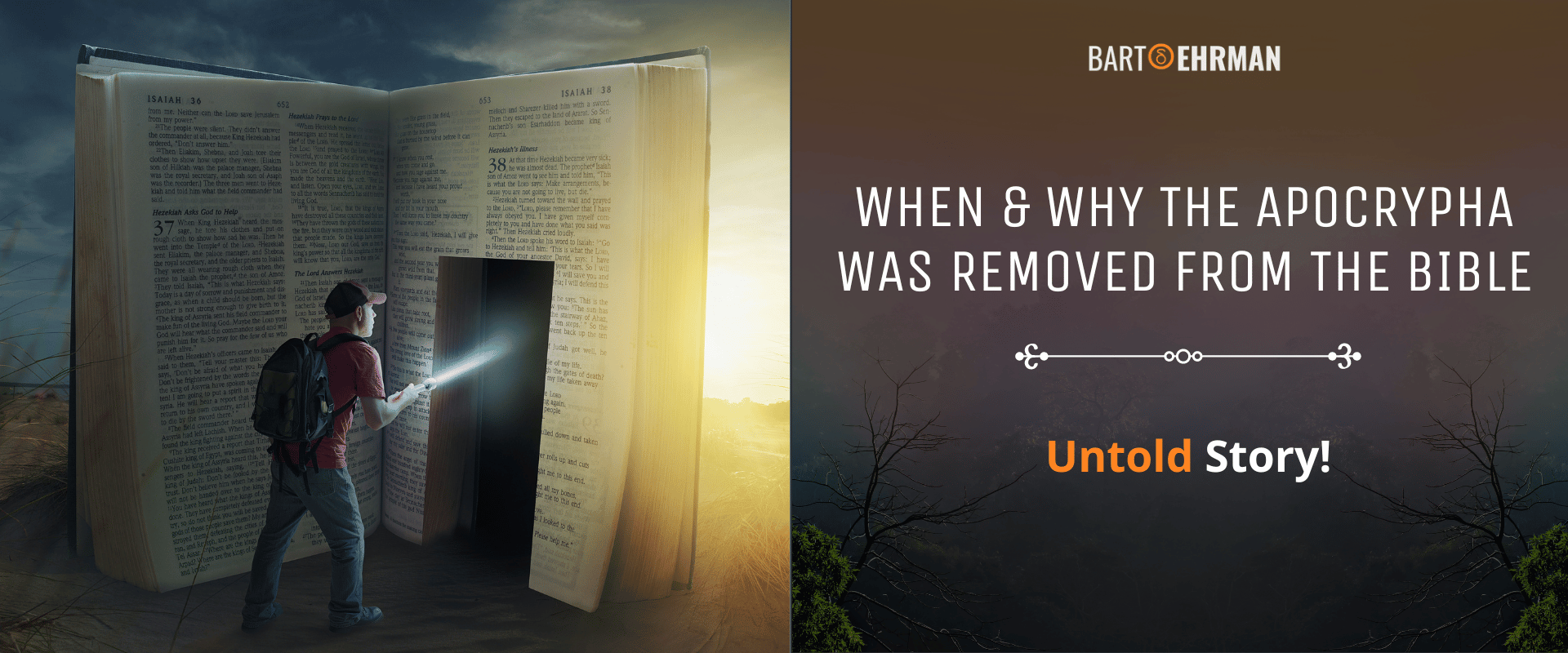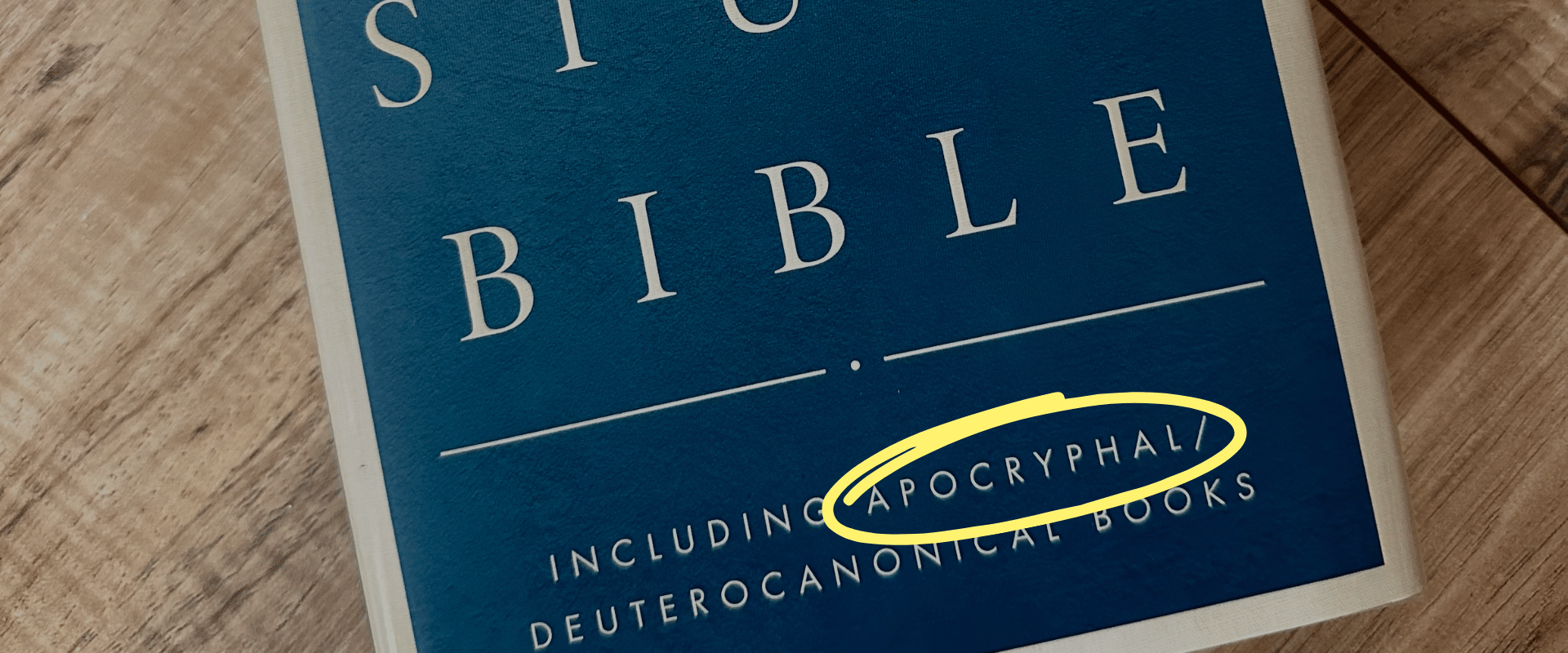When & Why The Apocrypha Was Removed from the Bible (Untold Story!)

Written by Joshua Schachterle, Ph.D
Author | Professor | BE Contributor
Verified! See our editorial guidelines
Verified! See our guidelines
Disclaimer: The views and opinions expressed in this article belong to the author and do not necessarily match my own. - Dr. Bart D. Ehrman
The Apocrypha, a collection of 14 controversial biblical books, stands at the crossroads of ancient religious texts and the developing canons of Judaism and Christianity. Their journey through history reveals a complex process of religious interpretation.
In fact, the Apocrypha shows the variability of canonization processes which have shaped both Judaism and Christianity. Its exclusion from some canons and inclusion in others highlights ongoing dialogues regarding sacred texts and their interpretations within diverse faith communities.
When was the Apocrypha removed from some canons, and why did other religious groups partially accept them? I’ll look at those topics and related matters in this article.

What Is the Apocrypha?
The Apocrypha is a list of 14 books that were ultimately excluded from the Hebrew Bible canon by Jews and by Protestant Christians who left them out of their Old Testament canon. The Greek word “apocrypha” simply means “concealed.”
According to The Apocrypha Oxford Bible Commentary by Martin Goodman, the word shifted meanings to “books outside the biblical canon” during the Protestant Reformation in the 16th century. In Hebrew, by the way, these excluded books are called “Sefarim Hachizonim,” meaning “external books.” (Affiliate Disclaimer: We may earn commissions on products you purchase through this page at no additional cost to you. Thank you for supporting our site!)
Despite the exclusion of these books, Jews and especially early Christians clearly saw at least some of them as Scripture at some point. Incidentally, while we now think of the Apocrypha as one whole unit, the books were written separately and considered separate, individual texts.
As such, different authors in different times wrote them and never considered them as one whole. This meant that some got accepted while others were rejected, depending on how specific religious groups interpreted them.
Who Wrote the Books of the Apocrypha?
Unfortunately, of the 14 books of the Apocrypha, we only know the author of one — the book of Sirach, also known as Ecclesiasticus. The author’s name was Jesus, son of Sirach. We know this because his grandson, Ben Sira of Jerusalem, translated the original Hebrew document into Greek and wrote a prologue. All the other apocryphal texts had anonymous writers.
When was the Apocrypha written? Fortunately, scholars have determined approximate dates of composition for each of the books. Without going into too much detail (you can find the dates of composition for each book in our other article on the Apocrypha), they were all written by Jewish authors, mostly during the Second Temple period (597 BCE-70 CE).
Was the Apocrypha Considered Canonical?
Again, the canonicity of the Apocrypha depends in large part on which group you examine. Its status differs between Jews, Protestants, Catholics, and Orthodox Christians.
While it’s not entirely clear when the Hebrew Bible canon (Hebrew: “Tanakh”) became solidified for Jews, Martin Goodman says it’s highly likely that the writings of the Apocrypha were initially taken by many Jews as inspired Scripture. Michael Stone notes, for example, that manuscripts of some books of the Apocrypha have been found among the Dead Sea Scrolls, making it clear that the Essenes who wrote and preserved those texts considered them to be Scripture.
However, early rabbinic writings only refer to one apocryphal text — the book of Sirach — and seem wholly unaware of all the others. This may be because the apocryphal texts were only available in Greek, although several books had been translated to Greek from Aramaic and/or Hebrew. On the other hand, Yehuda Shurpin writes of evidence that rabbinic writers may have viewed apocryphal books as contradictory to some of the principles in the rest of the Hebrew Bible.
Whatever its status in the past, the official Hebrew Bible canon today contains no books from the Apocrypha, the canon having long been closed.
In this sense, the Jewish Tanakh is very similar to most Protestant Old Testaments, which share the same 24 books, although in a slightly different order. Martin Luther, one of the first Protestants, included the apocryphal books in his 1522 translation of the Bible from Latin to German, but he placed them in a separate section after the Old Testament. In fact, it was he who first called them Apocrypha, claiming that they were not inspired Scripture but were still good for Christians to read.
When the King James Version (KJV), a Protestant endeavor, was originally made, it included the Apocrypha in a separate section, noting, like Luther, that while apocryphal texts were worthy of being read, they should not be considered inspired Scripture. When was the Apocrypha removed from the KJV? It officially happened in 1885.
Most modern Protestant Bibles don’t contain the Apocrypha at all, unless they are study Bibles used for academic purposes.
The Catholic position on the Apocrypha is that some of the books are inspired Scripture. They are, therefore, included in the Old Testament section of Catholic Bibles. These include Tobit, Judith, Wisdom, Sirach, Baruch, I and II Maccabees, and also extra sections of Esther and Daniel which are absent from the Protestant OT. The rest of the Apocrypha is not included in their canon. The Orthodox Church contains the same apocryphal texts as the Catholic but adds one more — the Prayer of Manasseh — to their canon.
How Influential Was the Apocrypha In Judaism?
While it’s called the Second Temple period in Jewish History, the period when most of the books of the Apocrypha were written overlaps with the Hellenistic period, measured from Alexander the Great’s death to just before the 1st century CE (323 BCE– 32 BCE). During this time, Jews located in Palestine and those part of the Jewish diaspora absorbed substantial Greek language and cultural influence.
Consequently, many Jews wrote new religious texts in Greek rather than Hebrew (the entire New Testament, for example, was written in Greek). Some Jews may have viewed them as less authentic than those written (or widely available) in Hebrew.
As I said above, the Book of Sirach is the only book of the Apocrypha referred to in the earliest rabbinic writings. However, even it was not ultimately included in the canon, although the rabbis said it was worthy of reading. Even though these non-Christian Jewish authors wrote these books, it was early Christians who would find apocryphal texts most useful.
How Influential Was the Apocrypha for Christianity?
To understand the Apocrypha, you have to know about the Septuagint, the Greek translation of the Hebrew Bible. All New Testament authors referred to it only for their scriptural references. For this reason, scholars know that the Septuagint was provided to the non-Jewish world through allusions from Christian writers.
Goodman notes that there are no direct quotations from the Apocrypha in the New Testament. However, several NT authors refer to images and stories from apocryphal texts. These authors may have read or simply heard them, indicating they were a pervasive part of 1st century Jewish culture.
Paul, for example, mentions imagery from the Wisdom of Solomon. In addition, Hebrews 11:35-37 speaks briefly of a martyrdom narrative from II Maccabees.
This collectively indicates that some 1st-century Christians might have considered these books canonical.
While the New Testament authors may have referred to the books of the Apocrypha, several early Church fathers actually directly quoted them. That is the case with the late-1st-century document known as 1 Clement, which quotes from the Wisdom of Solomon. The Epistle of Barnabas, another early Christian document, quotes from several other apocryphal books, while scholars widely accept that an early Church father named Polycarp referred indisputably in his writings to a story from apocryphal additions to the book of Daniel.
This shows that many in the early Church accepted the apocryphal books as Scripture.
Why Was the Apocrypha Removed from the Tanakh and Protestant Bibles?
Ultimately, the rabbis rejected the Apocrypha, viewing them as non-Scripture. One explanation given for this in the early rabbinic writing known as the Talmud is that apocryphal texts were written after the end of “the age of prophecy.” The canonical books, according to this theory, were written during the time when God communicated with his people through inspired prophets. In contrast, the apocryphal books, written after the end of that age, are not legitimate because they lacked divine inspiration.
In addition, some rabbinic writings said, as I mentioned above, that the apocryphal texts contradicted Jewish moral teachings. For example, one of the apocryphal additions to Daniel portrays Jewish Law incorrectly with regard to witness testimony, while the books of Enoch and Jubilees erred in their portrayal of the relations between God, angels, and humans.
As for Protestants, Devin Rose writes that, based on the writings of early Protestant reformers such as Martin Luther and John Calvin, there are two principal reasons the books of the Apocrypha were rejected as Scripture. The first is a passage in the apocryphal book 2 Maccabees, which refers to and praises the practice of praying for the souls of the dead. Protestants denied that this was an acceptable practice, although the Oxford Dictionary of the Christian Church says inscriptions found in the Roman catacombs and ancient writings by Tertullian and Cyprian prove that Christians had been doing it for centuries.
The second reason Protestants removed these texts is that Jewish authorities rejected the Apocrypha for the Hebrew Bible canon. Since Christianity grew out of 1st-century Judaism, Protestant reformers saw any books rejected by the Jews as equally undeserving of Christian canonical status.

Why Do Catholics and Orthodox Christians Accept (Some) Apocryphal Texts as Canon?
It is likely that the early Church fathers’ approval of apocryphal books explains in part why Catholic and Orthodox Bibles have included some of these books in their Old Testament.
In addition, the influential Christian bishop and theologian Augustine of Hippo (354 CE-430 CE) included seven apocryphal texts in his canon (Tobit, Judith, 1 and 2 Maccabees, Wisdom of Solomon, Sirach or Ecclesiasticus, and Baruch). This canon was then officially reconfirmed centuries later by the Council of Trent in 1546, affirming that these seven books were as divinely inspired as every other part of the Catholic Bible. As I mentioned above, Orthodox Bibles include these same books, plus the Prayer of Manasseh.
Conclusion
The Apocrypha is a set of 14 books that were ultimately rejected by both Jews and Protestant Christians. Despite the fact that, for convenience, we refer to it as one whole unit, it was actually comprised of a diverse set of texts, each written by different authors.
Besides the book of Sirach, aka Ecclesiasticus, the books were all written anonymously, much like the Gospels and many other sacred Jewish and Christian writings. Although scholars can make reasonable guesses about the books’ composition dates, even those are ultimately speculation.
When was the Apocrypha removed? That depended on the views of apocryphal texts among those who used them. Jews rejected all but the book of Sirach fairly early in their canon formation. The Talmud refers to it sparingly but to no other apocryphal books. This indicates they were not as influential within Judaism as within Christianity.
The New Testament authors, including the Apostle Paul and the author of Hebrews, made references to imagery from apocryphal books, indicating that those authors and others of their time accepted the books’ divine inspiration.
Later, Church fathers such as Polycarp and the anonymous authors of 1 Clement and the Epistle of Barnabas, made more direct references to apocryphal books, showing that in the first few centuries of Christianity, many considered them Scripture.
Jews would ultimately reject the Apocrypha, coming as it did after the age of prophecy in their estimation. Oddly, Protestants would follow suit, reasoning that if the Jews, whose writings had formed the basis for the development of Christianity, had rejected those books, they weren’t worthy of being called Scripture.
The seven books accepted by the Catholic Church as part of the canonical Old Testament were likely included as part of the continuation of Early Christian acceptance of those books. Orthodox Christians accept these, plus the Prayer of Manasseh, likely for the same reason.

